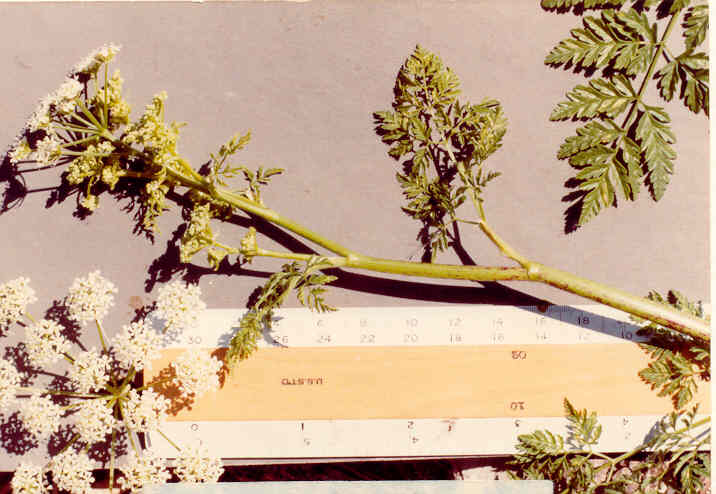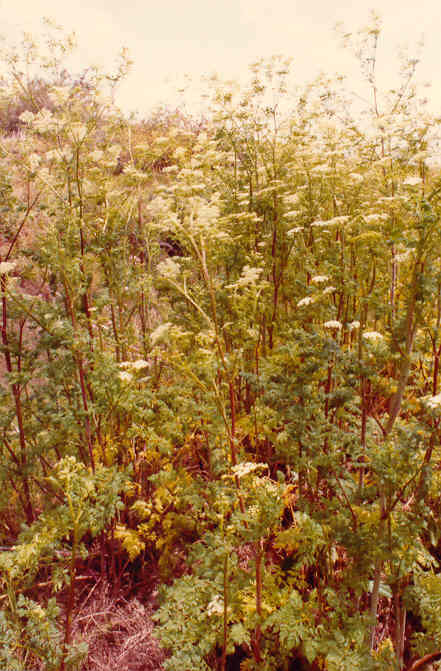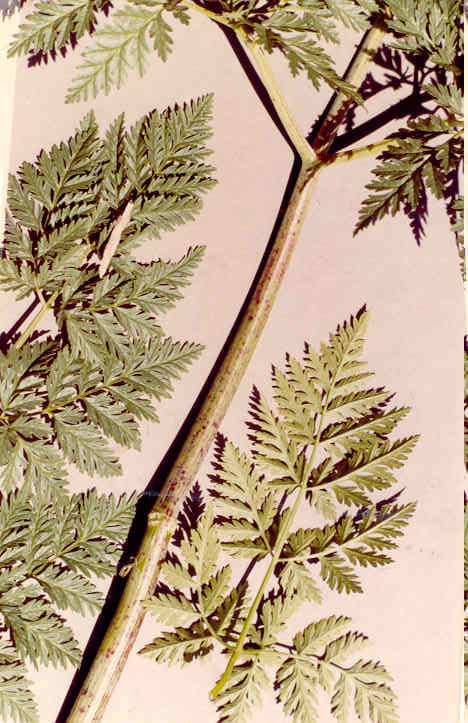
Conium maculatum L.
Apiaceae (Carrot Family)
Europe
 |
Conium maculatum L.Apiaceae (Carrot Family)Europe
Poison-Hemlock |
May Photo
Plant Characteristics: Tall
biennial glabrous herb with purple spotted stems 5-30 dm. high; lvs. pinnately
decompound; lower petioled, upper sessile, all finely dissected into segms.
ovate in outline, dentate or incised; lower lf. blades 15-30 cm. long; infl. of
compound, many-rayed umbels, rays 1.5-4.5 cm. long; fls. white; bracts of invol.
many, lanceolate, inconspicuous; fr. broadly ovoid, flattened laterally,
glabrous, 2-2.5 mm. long, the ribs prominent when dry; oil tubes obscure,
irregular.
Habitat:
Common in low waste places below 5000 ft., especially in cismontane
Calif.; San Nicolas Id. April-Sept.
Name:
Greek, coneion, the ancient
name for hemlock; maculatum, meaning spotted, tells us about the purple
splotches on the stems. (Dale 47).
General:
Common in the study area and usually in large colonies when found.
Photographs are from Big Canyon and Santa Ana Heights. (my comments).
There are two spp. in the genus, 1 Eurasian and 1 S. African. (Munz, Flora So. Calif.73).
The ancient Greek, Socrates, was forced to drink the poison from this
plant because he had the courage to publicly expound his beliefs, opposing those
of his more powerful contemporaries. (Dale
46). C.
maculatum contains several alkaloids that are relatively simple in chemical
structure among alkaloids, and are chemically related to nicotine.
These alkaloids work by depressing the function of the central nervous
system and bringing on paralysis. Death
occurs when the muscles used in breathing become paralyzed.
The poison is primarily in the foliage and seeds. (Kingsbury 65-66).
The name of the poison in C.
maculatum is coniine and the stems and leaves are the most poisonous parts. There
is evidence that the officials of Athens did not really want Socrates to die; he
was given many chances to plead guilty and receive a light sentence or even to
escape. But Socrates steadfastly
refused to admit any guilt or to run away, and so he was put to death.
At that time, noble Greeks were killed by being forced to drink a potion
made from the leaves of the spotted hemlock.
The symptoms of spotted hemlock poisoning come on rapidly.
Within fifteen minutes to an hour after swallowing enough of the seeds,
roots, or leaves, victims may feel nervous and begin to tremble.
Later, the hands and feet become numb, the heartbeat slows down and the
body feels cold. If the victim has
eaten a lethal dose, death will come from failure to breathe. (Eshleman 44,
104-107). C.
maculatum has been found to accumulate free nitrates in quantities capable
of causing death or distress in cattle. (Fuller
384). Fullerís
statement leads me to wonder if the poison in the plant is toxic to animals or
just to humans? (my comment).
Text Ref:
Hickman, Ed. 144; Munz, Calif.
Flora 1011; Munz, Flora So. Calif.
73.
Photo Ref:
May 1 83 # 16,17; April-May 84 # 3.
Identity: by R. De Ruff.
First Found: April 1984.
Computer Ref: Plant Data 138.
Have plant specimen.
Last edit 7/4/05.
 |
 |
May Photo April Photo